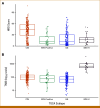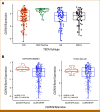Genomic Landscape of Late-Stage Gastric Cancer: Analysis From KEYNOTE-059, KEYNOTE-061, and KEYNOTE-062 Studies
- PMID: 40117530
- PMCID: PMC11949223
- DOI: 10.1200/PO-24-00456
Genomic Landscape of Late-Stage Gastric Cancer: Analysis From KEYNOTE-059, KEYNOTE-061, and KEYNOTE-062 Studies
Erratum in
-
Erratum: Genomic Landscape of Late-Stage Gastric Cancer: Analysis From KEYNOTE-059, KEYNOTE-061, and KEYNOTE-062 Studies.JCO Precis Oncol. 2025 Apr;9:e2400266. doi: 10.1200/PO-25-00266. Epub 2025 Apr 23. JCO Precis Oncol. 2025. PMID: 40267390 Free PMC article. No abstract available.
Abstract
Purpose: The Cancer Genome Atlas (TCGA) classifies gastric cancer (GC) into four molecular subtypes: Epstein-Barr virus-positive, microsatellite instability-high (MSI-H), genomically stable (GS), and chromosomal instability (CIN). This exploratory analysis compared the genomic landscape of late-stage GC from KEYNOTE-059, KEYNOTE-061, and KEYNOTE-062 studies with early-stage GC from TCGA and evaluated the genomic characteristics of late-stage GC in patients of Western and Asian origin.
Materials and methods: Using pretreatment tumor samples, bulk DNA was analyzed via whole-exome sequencing (WES; KEYNOTE-059/KEYNOTE-061) and FoundationOneCDx (KEYNOTE-062) to determine TCGA-defined molecular subtypes (only MSI-H is determinable from FoundationOneCDx), genomic alterations, homologous recombination deficiency (HRD), and tumor mutational burden (TMB); gene expression signatures were analyzed using RNA sequencing.
Results: When comparing KEYNOTE-059/061/062 combined WES and FoundationOneCDx data with data from TCGA, the MSI-H subtype prevalence was numerically lower in patients of Western (5% v 22%) and Asian origin (5% v 19%). When comparing KEYNOTE-059/061 WES data with the TCGA data set, the GS subtype prevalence was numerically higher (36% v 21%) in patients of Western or Asian origin. Among subtypes in KEYNOTE-059/061, HRD scores and TMB trended highest in CIN and MSI-H subtypes, respectively. TP53 mutation was the most prevalent genomic characteristic per KEYNOTE-059/061/062 combined analysis in patients of Western or Asian origin. Gene expression signature distributions were generally similar between patients of Western and Asian origin.
Conclusion: Numerical differences in the prevalence of MSI-H and GS subtypes were observed between early-stage and late-stage GC. Genomic characteristics of late-stage GC were generally similar between patients of Western and Asian origin.
Trial registration: ClinicalTrials.gov NCT02494583 NCT02335411 NCT02370498.
Conflict of interest statement
The following represents disclosure information provided by authors of this manuscript. All relationships are considered compensated unless otherwise noted. Relationships are self-held unless noted. I = Immediate Family Member, Inst = My Institution. Relationships may not relate to the subject matter of this manuscript. For more information about ASCO's conflict of interest policy, please refer to
Open Payments is a public database containing information reported by companies about payments made to US-licensed physicians (
No other potential conflicts of interest were reported.
Figures





References
-
- Lauren P: The two histological main types of gastric carcinoma: Diffuse and so-called intestinal-type carcinoma. An attempt at a histo-clinical classification. Acta Pathol Microbiol Scand 64:31-49, 1965 - PubMed
-
- Kim ST, Cristescu R, Bass AJ, et al. : Comprehensive molecular characterization of clinical responses to PD-1 inhibition in metastatic gastric cancer. Nat Med 24:1449-1458, 2018 - PubMed
-
- Shitara K, Özgüroğlu M, Bang YJ, et al. : Molecular determinants of clinical outcomes with pembrolizumab versus paclitaxel in a randomized, open-label, phase III trial in patients with gastroesophageal adenocarcinoma. Ann Oncol 32:1127-1136, 2021 - PubMed
MeSH terms
Associated data
Grants and funding
LinkOut - more resources
Full Text Sources
Medical
Research Materials
Miscellaneous

